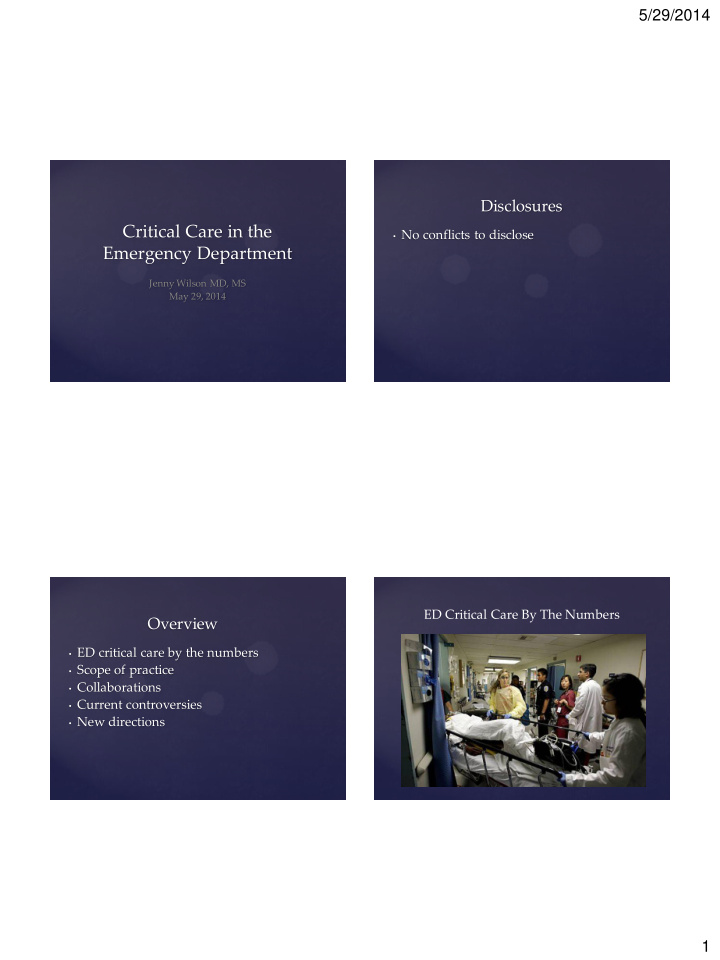



5/29/2014 Disclosures Critical Care in the • No conflicts to disclose Emergency Department Jenny Wilson MD, MS May 29, 2014 ED Critical Care By The Numbers Overview • ED critical care by the numbers • Scope of practice • Collaborations • Current controversies • New directions 1
5/29/2014 What percentage of ICU patients are admitted from the ED? Median ED LOS for Critically Ill? 20-40% A. <1 hr A. 40-60% 1-2 hrs B. B. 60-80% C. 2-3 hrs C. D. 3+ hrs Lilly CM, Zuckerman IH, Badawi O, et al. Benchmark data from more than 240,000 adults that reflect the Herring AA, Ginde AA, Fahimi J et al. Increasing Critical Care Admissions from US Emergency current practice of critical care in the United States. Chest. 2011; 140:1232 – 1242. Departments, 2001-2009. Crit Care Med 2013;41: 1197-1204. What the ED can do for you . . . Resuscitate the undifferentiated critically ill • patient --lines, tubes, electricity, fluid, blood Diagnose life-threatening conditions • Scope of Practice --e.g. stroke, MI, CHF, dissection, bleeding, acute abdomen, sepsis Initiate critical treatment early • --e.g. TPA, ASA, heparin, afterload reduction, antibiotics Triage to appropriate service/unit • Begin communication with family • 2
5/29/2014 What the ED (Often) Can’t Do • Focus 100% of resources on one patient for extended periods • Individualize initial work-up and treatment for all critically ill patients • Establish longitudinal therapeutic relationships Which Patient Do You See First? 2 week old infant with fever and A. lethargy 82 yo woman in Afib with BP of 85/60 B. 42 yo man with sore throat, hot potato C. voice, and pooling secretions 3
5/29/2014 Collaborative Care Collaborations • Trauma --Regionalization, ATLS • ACS --STEMI centers, protocols to minimize DTB time • Stroke --Stroke centers, EM/rad/neuro collaboration • Sepsis --Protocols/bundles • Post-Arrest Care --Cardiac Arrest Centers, targeted temperature management, invasive monitoring, etc. Controversies • Prehospital airway management • Ambulance diversion Limits of focused cardiac ultrasound • Controversies Epinephrine/early defib in cardiac arrest • Bypassing ED for cath lab activation • Target temperature in post-arrest patients • Sepsis care since ProCESS • Antifibrinolytic agents and transfusion ratios in trauma • 4
5/29/2014 Hasegawa K, Hiraide A, Chang Y, Brown DF. Association of prehospital advanced airway management with neurologic outcome and survival in patients with out-of- hospital cardiac arrest. JAMA. 2013 Jan 16;309(3):257-66. Shen YC and Hsia RY. Association between ambulance diversion and survival among patients with acute myocardial infarction. JAMA. 2011 Jun 15;305(23):2440-7. 5
5/29/2014 New Directions • ED ECMO • Novel decision rules, clinical scoring systems, and biomarkers New Directions • The ED ICU Sakamoto T et al. Extracorporeal cardiopulmonary resuscitation versus conventional cardiopulmonary resuscitation in adults with out-of-hospital cardiac arrest: A prospective observational study Resuscitation 85 (2014) 762 – 768 6
5/29/2014 Goto Y, Maeda T, Goto YN. Termination-of-resuscitation rule for emergency department physicians treating out-of-hospital cardiac arrest patients: an observational cohort study. Crit Care. 2013 Oct 13;17(5):R235. ED-Critical Care Pathways References Bellezo JM, Shinar Z, Davis DP et al. Emergency Physician-Initiated Extracorporeal Cardiopulmonary 1. Resuscitation. Resuscitation 2012;83:966. Callaway CW. Epinephrine for cardiac arrest. Curr Opin Cardiol. 2013 Jan;28(1):36-42. 2. Cha WC, Lee SC, Shin SD, et al. Regionalisation of out-of-hospital cardiac arrest care for patients 3. without prehospital return of spontaneous circulation. Resuscitation. 2012 Nov;83(11):1338-42. doi: 10.1016/j.resuscitation.2012.03.024. Epub 2012 Mar 23. Goto Y, Maeda T, Goto YN. Termination-of-resuscitation rule for emergency department physicians 4. treating out-of-hospital cardiac arrest patients: an observational cohort study . Crit Care. 2013 Oct 13;17(5):R235. Hasegawa K, Hiraide A, Chang Y, Brown DF. Association of prehospital advanced airway management 5. with neurologic outcome and survival in patients with out-of-hospital cardiac arrest. JAMA. 2013 Jan 16;309(3):257-66. Herring AA, Ginde AA, Fahimi J et al. Increasing Critical Care Admissions from US Emergency 6. Departments, 2001-2009. Crit Care Med 2013;41: 1197-1204. Shen YC and Hsia RY. Association between ambulance diversion and survival among patients with 7. acute myocardial infarction. JAMA. 2011 Jun 15;305(23):2440-7. Lilly CM, Zuckerman IH, Badawi O, et al. Benchmark data from more than 240,000 adults that reflect 8. the current practice of critical care in the United States. Chest. 2011; 140:1232 – 1242. Sakamoto T et al. Extracorporeal cardiopulmonary resuscitation versus conventional cardiopulmonary 9. resuscitation in adults with out-of-hospital cardiac arrest: A prospective observational study Resuscitation 85 (2014) 762 – 768 Stannard A, Eliason JL, Rasmussen TE. Resuscitative endovascular balloon occlusion of the aorta 10. (REBOA) as an adjunct for hemorrhagic shock. J Trauma. 2011 Dec;71(6):1869-72. Weingart SD, Sherwin RL, Emlet LL et al. ED Intensivists and ED intensive care units. American 11. Journal of Emergency Medicine 31 (2013) 617 – 620. 7
Recommend
More recommend